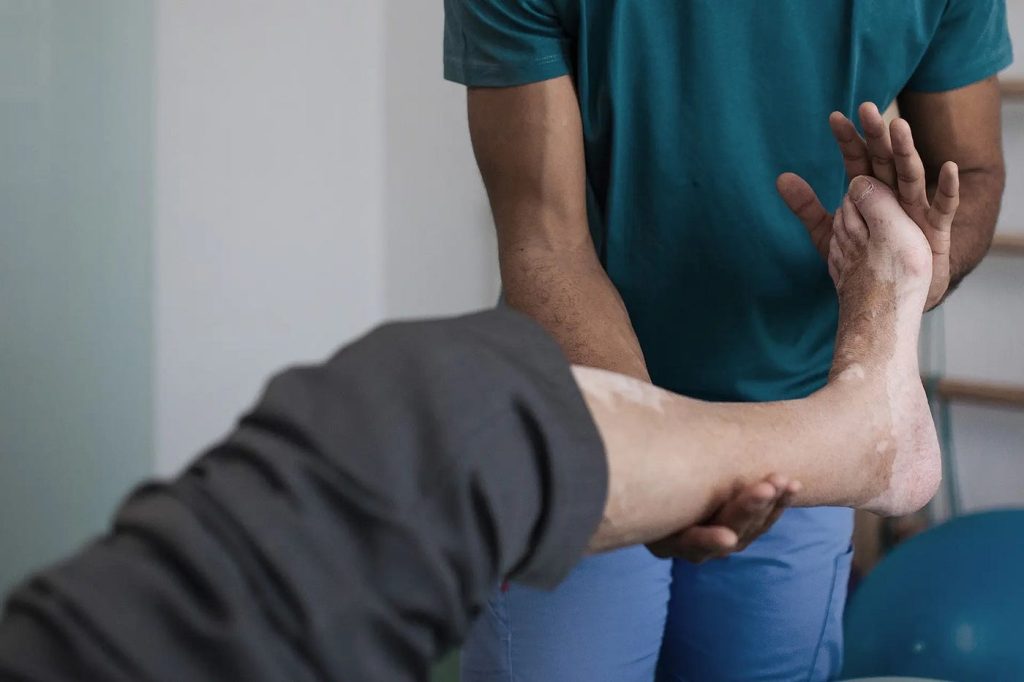
At CIONIC, we are obsessed with human movement — the science behind it and how we can use technology to improve mobility. One of the key features of the Neural Sleeve is that it can help generate essential motor movements, in particular dorsiflexion, which helps to lift the foot during walking. In the spirit of sharing our knowledge with our community, we wanted to share this piece on ankle mobility tests. Below is a guide to them — what they are, why they’re important, and how we conduct them.
Prior to joining Cionic, I worked in sub-acute rehab, outpatient orthopedics, acute care, and home health before deciding to go back to school to earn my Master of Public Health. I have worked with many patients to improve their ankle mobility and address neurologic diseases that impact gait — which often includes foot drop. Mobility is something I feel passionately about and is the reason I wanted to practice physical therapy. Working as a Mobility Specialist at Cionic has been the best move of my career!
All About Ankle Mobility Tests
An ankle mobility test is a tool used to help determine the range of motion and functional capacity of the talocrural joint and subtalar joint. The talocrural joint is a synovial joint consisting of the talus (a small bone in your foot), the tibia, and the fibula (the long bones of your lower leg). This joint is responsible for dorsiflexion (the upward lift of your toes) and plantarflexion (the downward point of your toes). The subtalar joint is a synovial joint consisting of the talus and calcaneus bones of the rearfoot. This joint allows for inversion (the rolling in of your foot), and eversion (the movement of your toes out and away from your body) of the ankle.
Have you ever sprained your ankle? If so, you know exactly how important this joint is to the function of your gait, recreation, and activities of daily living. Furthermore, utilization of an ankle mobility test is there to help us understand how we can optimize mobility. First, let’s discuss what could be impairing your ankle mobility.
Ankle mobility impairments
Runner’s World has a great article about the importance of ankle mobility. Something crucial the author points out is the difference between mobility and flexibility. We often use these terms interchangeably, but they are not actually interchangeable. Flexibility refers to the ability of a joint to move passively through a pain-free range of motion. Flexibility can be affected by limitations to the soft tissue surrounding the joint — think tight muscles!. Whereas, mobility refers to the ability of a joint to move actively through the range of motion and can be affected by limitations in the joints themselves as well as changes to the nervous system.
When mobility is impaired, the bones that make up the joint do not move over each other like they are designed to. These movements are referred to as the Arthrokinematics of a given joint. In the ankle, the talus and the tibia “roll and glide’’ on each other to produce dorsiflexion and plantarflexion. If something is inhibiting this roll and glide motion, the ability of our ankle to dorsiflex and plantarflex decreases.
Limitations to flexibility and mobility of the ankle can be caused by swelling, a fracture, dislocation, a growth (on the bone or in the soft tissue surrounding the joint), chronically poor positioning, or neurologic diseases (which we will get to later!). So, now we know what causes decreased ankle mobility, but how do we know if this is something we are dealing with? Here comes the ankle mobility test. Or tests, rather.
The Tests
*The following are tests commonly used to assess ankle mobility. Prior to attempting any of the below tests on your own, verify your personal ability to complete the test with your trainer or Physical Therapist! These tests do not take the place of a professional medical opinion.
The Half-Kneeling Dorsiflexion Test

Find a wall and take your shoes off. Adjust yourself into a half-kneeling position and place the tip of your great toe 5 inches from the wall with your knee stacked directly over your ankle. Keeping your heel on the ground, push your knee forward in an attempt to touch it to the wall. Can’t quite make it? This may be because you are dealing with some inhibited dorsiflexion.
The Squat Test

Stand with your feet hip-width apart, keeping your heels on the ground and your knees stacked behind your toes, drop down into a squat. When your knees bend to a 90-degree angle, stop. Slowly lower to increase the bend at your knee. If your heels need to come off of the ground in order to accommodate a deeper bend, you might have limited dorsiflexion.
A Measuring Test

For this test, you will need a trained professional. They will have you lay on your back with your legs straight. Keeping your knee in an extended position and cupping your heel, they will attempt to push your toes back toward the rest of your body. Using a goniometer, they will measure the degree of ankle dorsiflexion that you have. To walk without compensation, you need 10 degrees of dorsiflexion. Anything under this can contribute to impairment up the kinetic chain, like compensatory gait patterns that will lead to weak glute muscles, low back pain, and decreased balance.
Now What?
Addressing Decreased Ankle Mobility
If any of the above ankle mobility tests yielded less than desirable results, you may be wondering how you solve the problem of decreased dorsiflexion. A Physical Therapist can provide you with exercises, stretches, manual therapy, modalities (take note of this treatment!) and self-mobilization techniques to address your inhibited dorsiflexion. Sometimes, it might be as simple as waiting for the healing process to complete after a sprain, dislocation, fracture, or surgery — though it is never a bad idea to visit the professionals!
Neurologic Diagnoses
After reading these, you might be thinking, “but I can’t perform any of these tests on my own.” This is when it is time to seek assistance — most definitely from an expert. There are many diagnoses that can impact ankle mobility that also impair your balance and general lower body strength, preventing you from trying one of these tests independently. These diagnoses tend to be related to the central nervous system (CNS).
Neurologic conditions such as multiple sclerosis, stroke, and incomplete spinal cord injuries may result in a limitation in flexibility of the ankle as a result of tightness of the plantar-flexors. This may be due to spasticity or muscle tightness for which stretching or medications may help. These conditions may also result in mobility limitations as a result of weakness of the dorsiflexors or impaired motor control or coordination of the foot and ankle for which strengthening exercises and modalities may help.
Commonly experienced among those with diagnoses of the CNS is foot drop. This occurs when the nerves that tell the muscles responsible for dorsiflexion to contract, no longer communicate properly with the brain. This leaves individuals with toes that drag on the floor while walking, or compensatory gait patterns, used to clear the foot and avoid falling.
If you have a condition that limits your ankle mobility, your quality of life can trend downward. Suddenly, your toe catches on the floor while you are trying to walk to the kitchen. You are scared of falling when you get up in the middle of the night to go to the bathroom. You can’t drive your car anymore because your foot won’t move from the gas pedal to the brake. Tasks that you previously did without thinking suddenly require more intention.
CIONIC
If the above describes your mobility and you have a diagnosis of the central nervous system (CNS) that has impacted your mobility, then maybe we have a solution for you that could help alleviate some of that physical and cognitive burden: the Cionic Neural Sleeve.
You may have noticed that each ankle mobility test listed in the article targets dorsiflexion specifically. There is a reason for that! At CIONIC, we did a study on how the Neural Sleeve directly impacts this motion. Of our research participants, 94% saw an average increase of ~5 degrees of dorsiflexion. This is statistically significant considering the maximum degree of dorsiflexion is about 35, according to this article on PubMed.
Functional Electrical Stimulation to Improve Mobility
Among our research are also tests and measures regarding how Functional Electrical Stimulation (FES) addresses quadricep, hamstring, and gastrocnemius weakness. Since our sleeve targets all of these muscles (including the tibialis anterior, which is the main muscle responsible for dorsiflexion). That is a pretty comprehensive wearable device!
Recall the vocabulary word mentioned above — modality? The Cionic Neural Sleeve uses a well-known physical therapy modality to target weak muscles during gait: FES. FES stands for functional electrical stimulation. Our sleeve uses a dense sensor array to read what your body is trying to do and tell specific muscles to contract based on where it senses your body is in its gait cycle.
This means that instead of that pesky toe dragging on the floor while you are trying to swing your leg through during a step, the electrical impulses tell your primary dorsiflexors to contract at just the right time. This means the Neural Sleeve has the potential to help your toes lift and complete the swing-through phase of your gait cycle with greater ease. The same concept applies to the other targeted muscles of the sleeve. Pretty cool, huh?
Here at CIONIC, we all share a passion for those with movement challenges. We have dedicated our time to assisting those individuals in their journeys toward a more independent and unimpaired mobility lifestyle. Technology is always changing and adapting, so if the listed diagnoses do not describe yours, you can still join our newsletter to stay up to date on any new developments and head to the other articles in our blog for examples of just how quickly our world is advancing.
We want to hear from you!
If you have performed an ankle mobility test or two and find that your mobility leaves something to be desired, then head to your friendly neighborhood Physical Therapist for more help in correcting this! If you have a neurological diagnosis that was listed here and has left you with foot drop or other mobility concerns, contact our team and we can determine if the sleeve is a good fit for you.
The process is simple. Head to cionic.com, sign up and we will notify you when it is your turn to purchase the sleeve. Voila. You are on your way to better mobility with one of the most advanced wearables on the market.





